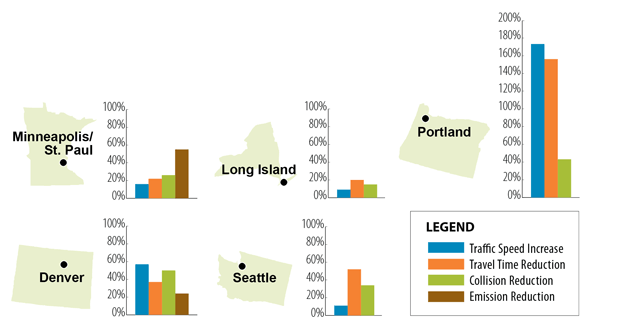About Ramp Metering
Ramp Metering Goals
An agency's goals and objectives for ramp metering should be consistent with regional transportation goals and objectives, which will vary from region to region. Often these goals and objectives are driven by the needs and areas of opportunity for a region. For instance, one region may want to improve safety and another may prioritize increasing mainline speed. Alternatively, some regions may want to encourage HOV and transit use. Some common priorities among agencies are safety, mobility, quality of life, environmental effects, and motorist perceptions and satisfaction.
Ramp Metering Benefits
When agencies implement effective ramp metering programs using strategies suitable to the region, they often realize significant, long-term benefits. While the magnitude of the benefits may vary depending on the level of congestion and configuration, common benefits persist across many regions. The widespread benefits of ramp metering, relative to its costs, make it one of the most cost-effective freeway management strategies.
Mobility, Reliability, and Efficiency
Ramp metering reduces mainline congestion and overall delay, while increasing mobility through the freeway network and traffic throughput. Travel time reliability has become an important measure of ramp metering effectiveness that is linked to reduced travel times. Many regions have experienced increased travel time reliability due to ramp metering.
Safety
Ramp meters help break up platoons of vehicles that are entering the freeway and competing for the same limited gaps in traffic. By allowing for smooth merging maneuvers, collisions on the freeway can be avoided. Many regions have reported significant reductions in crash rates after starting ramp metering. Effective ramp queue management can prevent queues from spilling onto the adjacent arterial and clogging up the city street network with stopped vehicles that are waiting to enter the freeway.
Reduced Environmental Impacts
Ramp meters smooth the flow of traffic entering the freeway so vehicles can merge with mainline traffic with minimal disruption to traffic flow. Eliminating prolonged periods of stop-and-go conditions due to congestion can reduce vehicle emissions and fuel consumption on the freeway. It can be argued that emissions and fuel consumption increase at the ramp meter, which is why the environmental analysis must be sensitive to actual ramp operations and fuel estimation methodologies, especially with the prevalence of electric vehicles on the roadway.
Though it is typically difficult to measure, many regions have attributed reductions in carbon emissions and fuel consumption to ramp metering implementation.

Source: FHWA Ramp Management and Control Handbook.

